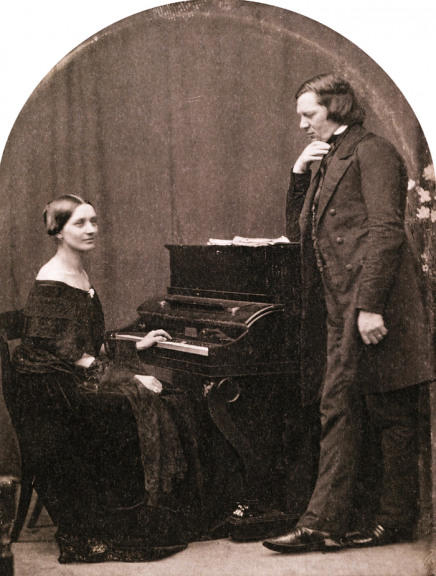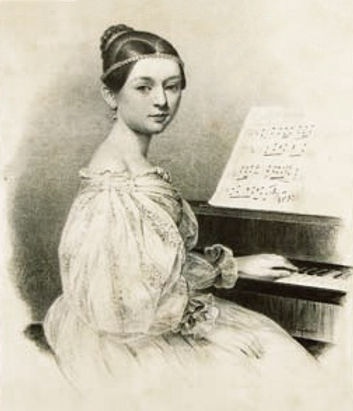Clara Schumann: Unsung Musical Powerhouse

Clara Schumann with her husband, Robert Schumann
For too long, female composers of the past have been consigned to the footnotes of music history textbooks. Although Clara Schumann (1819–1896) is one of the most famous examples, given her marriage to Robert Schumann (1810–1856), her contributions to music history as a composer, performer, and teacher have largely gone underreported. When she is discussed, the narrative often centers around her marriage to Robert and speculates about the nature of her relationship with Johannes Brahms.
That said, the impact Clara had on the life and career of her husband cannot be overstated. Clara not only birthed eight children between 1841 and 1854 and managed the household, but she was also the primary breadwinner of the family, maintaining an active performing career and using her international reputation as a piano virtuoso to champion Robert’s works. To Robert, Clara also served as a vital creative adviser, especially in writing for the piano. Robert had lost much of the feeling in the middle finger of his right hand from over-practicing and experimenting with a finger-strengthening device called a chiroplast. Unable to do his piano works justice, he composed them for Clara’s hands. (She was the better pianist anyway.) Robert recognized the immense value of this partnership even before they married, writing to Clara in 1839, “You complete me as a composer, as I do you. Every thought of yours comes from my soul, just as I have to thank you for all my music.”

Clara Schumann, née Wieck, was born in Leipzig in 1819 to a family of musicians. Her mother, Mariane, was a talented singer and pianist, and her father, Friedrich, was a piano teacher. A domineering figure, Friedrich pushed Clara into a career as a child prodigy and controlled every aspect of her life. She made her debut at the Leipzig Gewandhaus at the age of nine and had toured throughout Europe by her early teens. Composition and improvisation were integral to her artistic development, and at 14, she premiered her Piano Concerto in A Minor, op. 7, with Felix Mendelssohn at the podium.
Robert Schumann, then a 19-year-old law student, first came to study with Friedrich Wieck in 1828. Forsaking his legal studies and his mother’s wishes, he eventually moved in with the Wieck family in 1830 for intensive training, staying there for about a year. Despite the nearly 10-year age gap, Robert and Clara soon struck a friendship and creative partnership. Robert dedicated a number of keyboard collections to Clara, and Clara reciprocated (see Romance variée, op. 3, written in 1832).
Pianist Lara Downes, who recorded an album of Robert and Clara’s piano music in 2019, said in an interview with the New York Times, “Their music is so profoundly connected that you really can’t separate the one from the other. From the very beginning, they were so deeply enmeshed, always listening and sharing, consulting and collaborating. It’s like all of the music they produced carries both sets of genes.” The two composers would often include nods to each other’s work in their compositions, Robert quoting a motif of Clara’s and vice versa, like a secret code. Clara also premiered virtually all of Robert’s piano compositions.
Eventually, the couple became more than just professionally entwined. They shared their first kiss in the fall of 1835 when Clara was 16. Friedrich vehemently opposed the match and warned Robert against seeing her “upon pain of death.” He even sent his daughter away on prolonged concert tours to separate the two and forced them to burn their letters. After 16 months apart, they rekindled their romance through secret correspondence and clandestine meetings. When Robert asked Friedrich for his permission to marry Clara in 1837, he refused out of hand. (At the time in Saxony, a woman under the age of 21 needed both her parents’ permission to marry.) Friedrich threatened to disinherit Clara, seize her concert earnings, and sue the couple if they married, claiming that Robert was a drunk who could not financially support a wife. But love will out, and after much back and forth, the courts finally ruled in the couple’s favor. Clara and Robert married on September 12, 1840, one day before Clara’s 21st birthday.
Early in their marriage, Clara expressed reservations about her new role as a wife, which traditionally meant being financially dependent upon her husband and, in their case, creatively deferential. However, composition was poorly paid in comparison to performance, particularly as Robert was not yet well known, whereas Clara was. She supported the family with her concertizing to allow Robert to dedicate himself to composing. Though Robert was supportive of her compositional efforts and contacted publishers on her behalf, his work still took precedence, and she had to limit her practicing and composing to when it would not disturb his own work.
Her tireless work ethic sustained Robert through various mental and physical illnesses. After he attempted suicide in 1854, Robert requested admission to a sanatorium. With Clara pregnant, doctors advised her not to visit him for the sake of her and the baby’s health. She only saw her husband one more time, just two days before his death in July 1856.
As a young widow at 37, Clara devoted herself to honoring her husband’s memory and supporting her seven surviving children through extensive recital tours. Her efforts established Robert Schumann as one of the greatest composers of the Romantic era. Not only did she perform his compositions on tour, but she also edited his complete works and created arrangements and piano transcriptions.
Her contributions extend past the associations with her husband. Her performing style and teaching would influence generations of pianists. In 1878, she was appointed principal piano teacher at the music conservatory in Frankfurt. The first woman to teach there, Clara attracted students from far and wide, leaving a substantial pedagogical legacy in her unique approach to the instrument and repertoire. In particular, she bolstered the careers of her female students, who were often forced to give up their pianistic aspirations after marriage, by introducing them to her vast professional network.
Throughout her six-decade performing career, she helped establish the convention of pianists playing from memory in recitals and concertos. She also took a different approach to programming than many of her predecessors and contemporaries. Instead of highlighting her own virtuosity with flashy transcriptions, she preferred to elevate the composers on her programs. While audiences at the time mostly expected new works, her recitals were unusual in their inclusion of pieces by historical composers such as Bach and Scarlatti alongside contemporary works.
Clara essentially stopped composing after her husband’s death. (She only put pen to manuscript paper once more to write a march for a friend’s anniversary in 1879.) As a result, she leaves behind just 23 published works, most of which fall within the “acceptable” realm for a female composer of lieder, piano literature, and chamber music. She also seldom performed her own compositions after Robert’s death, contributing to her works falling into obscurity. This began to change in the 1970s, when the first recordings of her music appeared. While her compositional output is relatively small, we cannot judge her legacy solely on her compositions. As we have explored, her contributions to music history are far more wide-reaching than what she left on the page.



